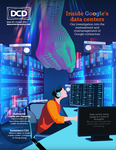Even before Covid-19 hit, networks were becoming massive in scale. Now in the post-pandemic world, as expanded connectivity needs become permanent, networks are not only growing even larger, but they are also becoming more dispersed, more devices are accessing the network than ever before, and cyber threats have become pervasive and more sophisticated. While it may have been possible to manage and secure networks without the benefit of intelligent, automated tools 20 years ago, it’s now become an unfeasible task.
It’s critical that businesses leverage AI and modern automation technologies to support their business needs while keeping users safe. A raft of new technology and applications have emerged over the past several years, spanning everything from IoT devices to edge computing, that have conspired to dramatically increase data center complexity – and there’s no end in sight.
All the while, data centers are suffering through a staffing crisis driven by phenomenon like the “Great Resignation” where talented employees are looking for a change in career or work type, and in turn, causing an insufficient supply of qualified workers globally. At a time when data center operation teams can’t fill their open positions – and even those won’t be enough to support increased demand – automation becomes critically important.
Automation Simplifies day to day operations
Implementing automation offers immediate benefits in the form of lower costs due to greater efficiency, faster resolution times, lower risk of human error and a reduced attack surface to help guard against data security breaches. Even better, some automation software can configure changes across multi-vendor environments, providing more flexibility to businesses strategy, and more efficiency through unified management. In addition to immediately quantifiable benefits, an automated system can also streamline an operation’s processes for the long haul.
By acting as a single source of truth for all changes in the network, and a repository of the state of the network over time, an automated system can enable the network to be self-documenting – where all changes are tracked precisely and can be audited comprehensively. Thorough documentation saves time when things go wrong, making it easier for operators to take corrective action, or for the system to simply perform appropriate corrections on its own. Reducing the number of manual inputs and actions required by human operators can improve accuracy and efficiency, while also eliminating monotonous tasks for employees.
The move to remote and hybrid workforces has increased network complexity for many organizations. Intent-based Automation offers a solution to these new challenges as well. Employees across the enterprise are connecting from more devices through more networks than ever before. Today’s dispersed work landscape demands software that can configure devices automatically and at scale, while also guaranteeing reliability and security.
Ensuring security and reliability
With the advent of hybrid and fully remote work, it’s crucial to ensure that security is a top priority throughout the network. An unprecedented number of devices across different networks are accessing critical applications housed in data centers. As a result, the number of potential threats has increased as well. Securing this distributed traffic manually is no longer realistic given the sheer scale. Leveraging AI to improve security across data center operations is a prudent way to keep networks safe and reliable no matter the size.
With self-regulated data center software, versioning is automatically kept up to date so that potential vulnerabilities don’t slip through the cracks, and instead are raised in real time. DC operators alone simply cannot shoulder the burden of being able to “see” and “detect” everything on the network. Security automation can monitor new connections into the data center, and make sure only legitimate users, approved devices and authorized services are able to gain entry.
Automation alongside human workers
Since the very early days of the industrial revolution, the question “will machines and automation take over jobs?” has persisted. However, just as it’s not possible to build skyscrapers without the appropriate tools and machinery, it’s no longer possible to manage massive, complex data centers without the appropriate tools – and in today’s world, the right tools are AI-based automation. Data center automation offers a way to help human employees cope with what would otherwise be an impossible undertaking.
Partially as a response to the tech worker staffing crisis, efficient data centers management teams now hand off repetitive tasks, monitoring, and remediation processes to an intelligent, always-on automation platform. This way, human IT workers can focus on managing more complex tasks and revolutionary projects that are more critical to the company’s strategy, rather than wasting their time and resources on menial data entry or monitoring tasks. The result is an increase in efficiency and reduced risk of burnout and human errors.
Building modern data centers
As the worlds of both business and leisure activities become increasingly digitized, businesses have responded by growing and expanding data centers to handle this increase in demand. As a result, data centers are simply becoming too complex and too distributed to stick to old-fashioned operating processes.
To ensure quality of service amidst all these changes, data center operations must adapt by augmenting their existing manual processes with end-to-end automation designed to simplify the task of operating networks. Adopting tools that can configure devices automatically and at scale, while also guaranteeing reliability, will be key to handling increased demand amidst a staffing crisis.
Partnership between humans and automation in the data center leads to streamlined operations, lower costs, smaller risk for human error and overall safer and more reliable networks. Leveraging automation is the best practice to navigate through on-going changes while ensuring quality of service, and organizations who wait to implement innovations risk losing out on the reliability, security, and efficiency offered by modern solutions. They also risk losing top talent to competitors who are able to offer more interesting, lower stress jobs with less busy work. The implementation of AI and automation is mandatory for the future of data centers – and the future has already begun.


